What You Need To Know From The Recent Findings Of 7 Big Climate Reports
It is, in a word, “bleak.”
The world is rapidly accelerating toward climate catastrophe, our financial institutions have their foot on the gas and pinning our hopes on Chinese leadership to desperately wrench the steering wheel away from the guardrail looks increasingly foolish.
But, hey! At least a growing percentage of Americans recognize that the federal government should do more about climate change.
Last chance to become a HuffPost founding member!
Sign up for membership to become a founding member and help shape HuffPost’s next chapter
Those are just a few findings contained in seven reports published in the past week examining the climate emergency ahead of next week’s United Nations summit in Madrid.
The 25th Conference of the Parties was intended to be a forum for countries to up the ante from the 2015 Paris Agreement. They were supposed to come with new, more ambitious pledges to meet the targets and build on the momentum of the four years since the agreement was reached. Instead, the reports out since Nov. 20 illustrate the extent to which the world’s most powerful institutions are still engaged in a game of lethal procrastination that threatens to speed up global ecological collapse and sow chaos throughout human civilization in the decades to come.
Here’s a quick breakdown of what the reports found:
1. Global temperatures are on pace to rise as much as 3.2 degrees Celsius by the end of the century ― more than double what scientists project to be a safe range that remotely resembles our world today.
That came from the United Nations’ latest grim assessment of the so-called emissions gap between the amount of planet-heating gases countries agreed to cut and where the current projections are headed. The Paris Agreement aimed to cap average temperatures at 2 degrees Celsius above pre-industrial levels; a U.N. report last year determined that the pact’s more ambitious goal of 1.5 degrees Celsius of warming would likely cost hundreds of millions of lives and about $54 trillion in today’s dollars. Global temperatures are already a little over 1 degree Celsius compared with the period before the advent of industrial fossil-fuel use.
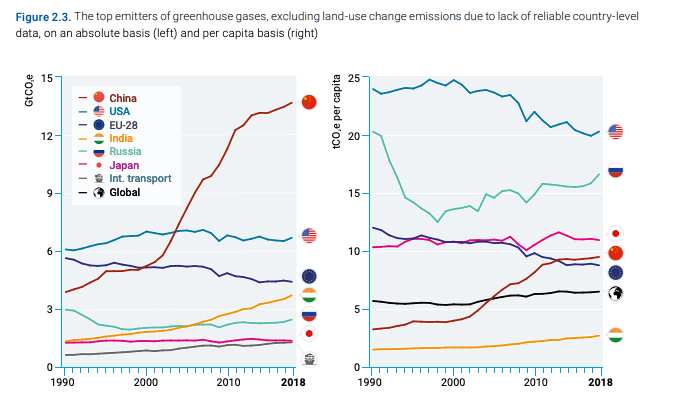
To keep warming within 1.5 degrees (about 2.7 degrees Fahrenheit), the world will need to cut emission 7.6% every year from 2020 to 2030, the report published Monday found.
“The summary findings are bleak,” the assessment stated.
2. The top 10 fossil-fuel-producing countries are on track to extract 120% more oil, gas and coal than would be consistent with 1.5 degrees of warming.
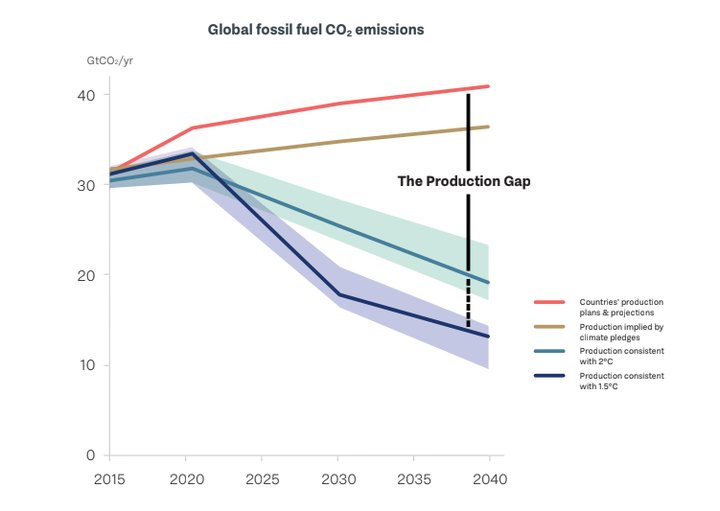
There isn’t just an emissions gap. There’s a production gap, too. That’s what this first-of-its-kind analysis by scientists at six organizations, including the United Nations Environment Programme, found last week. Projections to extract new fossil fuel reserves in China, the United States, Russia, India, Australia, Indonesia, Canada, Germany, Norway and the United Kingdom exceed the limits to keep warming within 2 degrees Celsius by 50%. That figure surges to 120% when modeled for 1.5 degrees Celsius.
3. The world’s biggest asset managers remain heavily invested in climate-polluting industries ― and do little if anything to convince those companies to change.
That’s the finding of a sweeping survey by the British think tank InfluenceMap of the 15 largest asset managers that control a combined $37 trillion. Only three big firms ― UBS Asset Management, Allianz and Legal & General ― “strongly and consistently engage with the companies they invest in to align their business models with Paris targets.” The report found $8.2 trillion invested in four top-polluting industries: oil and gas, coal mining, automobiles and electric power.
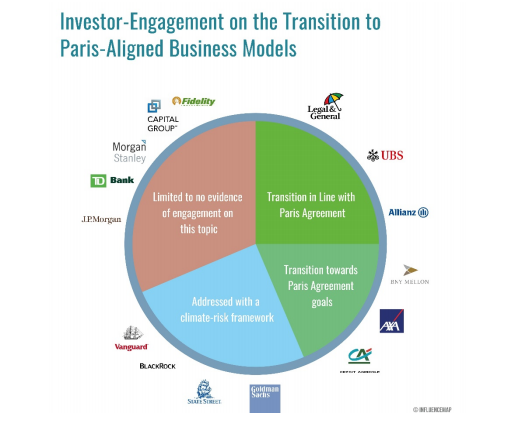
“Forceful engagement with the companies in these sectors to hasten their transition to low carbon technologies must occur if the finance sector wishes to align its portfolios with climate goals,” the report stated. “The majority of companies in these sectors are very far from aligning their business models to meet the goals of Paris.”
4. The insurance industry looks stunningly unprepared for the “extremely high” risks of climate change.
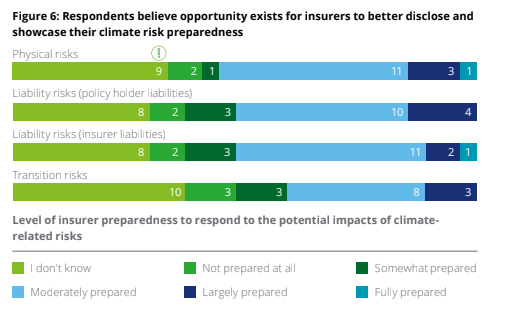
So say insurance regulators in a survey released Monday by the professional services giant Deloitte. As the costs of extreme weather have soared over the past decade, with the number of disasters causing $1 billion or more spiking dramatically since 2010, the 27 regulators surveyed from the National Association of Insurance Commissioners painted a picture of an industry stumbling largely in the dark. One-third of regulators said they did not know how well insurers are prepared to deal with the effects of climate-linked financial instability. Among those who said they were prepared, no more than four respondents in the weighted survey said insurers were “largely or fully prepared.”
Similarly, one-third of regulators said they did not know whether current insurer risk models were up to the task of capturing and testing climate-related risks. Among those who knew, only two said the models were “very good” and none rated them as excellent.
5. New investments in wind, solar and other renewable energy projects dropped sharply in the developing world last year. Coal, meanwhile, hit a record high.
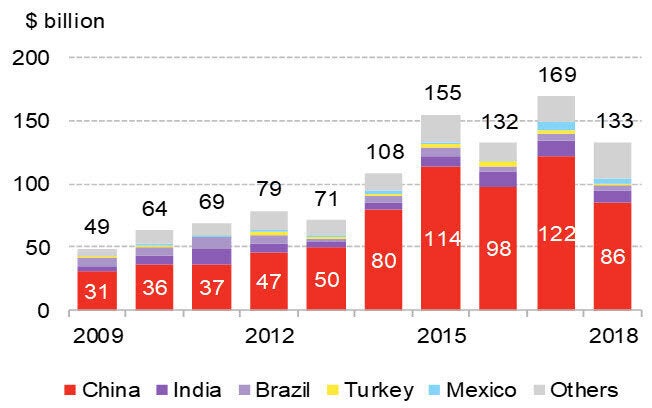
From 2017 to 2018, investments in new clean-energy infrastructure in 104 emerging markets fell from $169 billion to $133 billion, according to a report published Monday by the research firm Bloomberg New Energy Finance. China ― the world’s No. 1 emitter of greenhouse gases ― led the decline, investing $86 billion in renewable energy projects in 2018 compared with $122 billion in 2017.
Coal surged. The volume of coal-fired power generated and consumed in developing countries climbed to 6,900 terawatt-hours in 2018, up from 6,400 in 2017.
6. China is building more new coal plants than exist in all of the European Union.
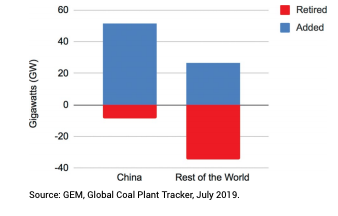
In 2017, China earned worldwide acclaim for canceling plans to build 103 new coal plants. It was a convenient political narrative that drew a stark contrast with the United States, where newly inaugurated President Donald Trump was preparing to withdraw the world’s second-largest greenhouse gas emitter from the Paris climate pact.
But a Global Energy Monitor report published Nov. 20 found that China has close to 147.7 gigawatts of coal power capacity under construction or likely to be resumed after being suspended. That nearly amounts to the European Union’s entire 150 gigawatts of coal capacity.
7. The vast majority of Americans want the federal government to do more to curb climate change and protect the environment.
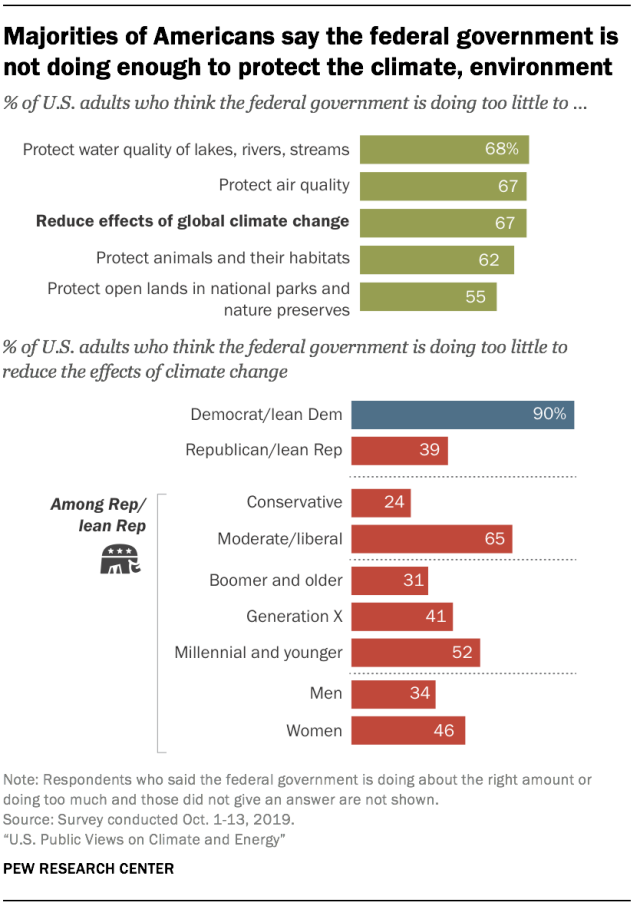
The numbers released Monday by the Pew Research Center illustrate why the issues are taking on such a big role in this election cycle. At 67%, the vast majority of American adults said “the federal government is doing too little to reduce the effects of global climate change.” Another 67% said the same of protecting air quality, and 68% said officials in Washington should do more to “protect water quality of lakes, rivers, and streams.”
Yet the climate question broke down along partisan lines. Among Democrats and voters who lean Democratic, 90% said the federal government needed to do more to curb the climate crisis. Among Republicans and those who lean Republican, that figure fell to 39%



Geen opmerkingen:
Een reactie posten